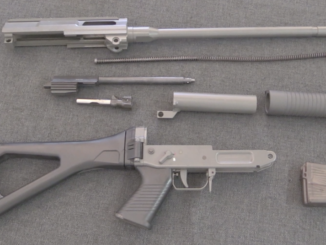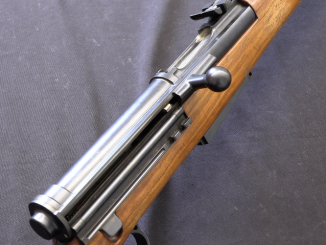When SIG was developing the pistol that would ultimately be adopted as the m/49 by the Danish Army and the P49 by the Swiss Army (P210 commercially), they initially experimented with both single stack and double stack variations. Today, we will take a look at a SIG 44/16, the double stack version – both on the table and out at the range.
Related Articles

Bolt Action Rifles
SIG’s Pump Action 550 Rifle: the 550 VRB
In many countries, manually operated rifles are substantially easier for civilians to own than semiautomatic ones – and this was not lost on firearms manufacturers. In an effort to potentially open a new market, SIG […]

Uncategorized
Stamm-Saurer Model 1913 Long-Recoil Prototype Rifle
Hans Stamm developed a series of firearms in Switzerland in the early 1900s, and today we are looking at a second-pattern Model 1913 semiauto rifle. This was developed while Stamm was working for the Saurer […]

Bolt Action Rifles
2-Gun Match: Swiss K31 (Video)
I’ve been looking forward to shooting one of the local 2-Gun Action Challenge Matches with a Swiss straight-pull rifle for a while now, and had the chance this past weekend. I was debating between using […]

Amazing. Sometimes they build better than they knew.
So this is how missing link between P210 and CZ 75 looked like 😉
Super! Thanks!
Before, I only read about it.
However, it seems now it is clear, why the version with the 8-round mag went to the service.
They did not dare to copy the design of the P35 mag, but instead took the MP38 mag as a basis.
No wonder it did not work properly.
It’s strange why they didn’t take the Furrer’s Lmg-Pist 41/44 mag as a base?..
Where do you get “it did not work properly”? Ian’s hands-on testing resulted in him labeling it “the best”. His research seems to indicate that it was rejected by a target-shooting club for having a wide grip.
I for one don’t think it’s clear at all why this led not only to it not being sold to any militaries, but also continuing in obscurity despite the recent reintroduction of the P210 – in an era when not only are double-column 9mms standard and expected, but there are numerous materials (not only polymers, but composites and wood laminates) that make excellent slim grips.
In 1947, the market was saturated by war production pistols. Add in that several major armies such as the French and Italians were actively producing their own new pistols. The British Commonwealth was going with the GP35, given WW2 experience with the gun and it being available from a Canadian production line. Add that the SIG product was expensive. It was produced from milled parts and the tolerances were very tight. They had to be for the internally mounted slide. The tight tolerances, excellent materials and quality production resulted in a very smooth and accurate pistol. It also resulted in a very expensive pistol. The adoption by the Danes was partly political, despite the availability of P38s. The Swedes were beginning to see wear in their Lahtis from “hotter” ammo and most of the available products were from major powers that were beginning to coalesce into the Cold war blocs. The Swiss needed to replace their Lugers and a Swiss gun made sense. But for everyone else, the either had something that worked or something less expensive that worked fine as a combat personal defense weapon.
Those are all very good reasons why a[ny] new pistol wouldn’t be adopted post-WWII, but they actually have nothing to do with my question.
Given that few militaries DID adopt P210-type pistols, and that both Ian’s hands-on experience and historical research reflected favorably on the double-column magazines, I was surprised to see numerous YouTubers (and Stiven, here) make comments like “THAT explains why they went with an 8rd mag!” i.e. the seeming opposite of the review’s conclusions. Stiven answered that other information, not noted in the video, indicated that they were unreliable.
And again, now that SIG has reintroduced the P210 into a civilian market where the state of the art / general expectation is a double-column 9mm, and SIG now has numerous reliable double-column magazines of their own, it is bizarre that this still isn’t even an option.
According to my sources, Major Björn Zachrisson of the Swedish army’s administration for hand weapons, visited SIG in Switzerland during the spring of 1946. Where he not only showed interest in pistol development, but also in light infantry weapons, autoloading rifles and submachineguns. SIG was then contacted by the Swedish sports-shooting association, who were evaluating a replacement for their German luger pistols, which were no longer in production. Later in the same year, SIG sent several model 44/16 pistols to Sweden for evaluation. These most certainty included SN 6018 & 6019 (6019 being featured in the Video above), both with 16 round magazines. The model 44/16 pistol was developed during the 1943 trials conducted by the Swiss military and competed with the pistol W+F 43 from Waffenfabrik Bern. These trails came to a halt in 1945 and the Pistols were therefore available for testing by the Swedes.
The Swedish sports-shooting association requested two changes to the design, the first one being the narrower grip with an 8 round single stack mag, like Ian mentioned, and the other an exchangeable barrel to fire 7.65 Parabellum. I could not find any mention of susceptibility to dust being a concern, as one person mentioned in a comment. This may have been a problem with the model 44/8, a variation of the Petter M1935, also tested in the early stages of the swiss military trails.
The only information I could find regarding an unreliable magazine was from SIG themselves. However, it only regarded the single stack magazine when loaded with 7.65 para. This was resolved as a P210 mag can be used reliably for both 9mm and 7.65 para. It is also noted that to meet the request in a timely manner, the newly made single stack frame, SN 6028, was fitted to the slide and hammer assembly, taken from SN 6018. This means, that in theory, a 47/8 (P210) slide can be fitted on a 44/16 frame. (SN 6018 was later pictured with a “new” 47/8 slide and a narrow production hammer.)
By the time the Swiss concluded their trail, the 47/8 had already gone into production and it is probable that this influenced the decision to adopt the P49 in single stack as the Swiss military sidearm.
How did this SIG prototype compare to the M9 pistol for weight and bulk?
The M1911A1 weighs in at 39 ounces empty and the M9 is about 34 ounces; eight rounds of .45 ACP plus a magazine weighs about as much as 16 rounds of 9mm NATO plus a magazine. There may be a quarter pound difference between a loaded M1911A1 and an M9–I could be unscientific and weigh the two fully loaded on my food scale, I guess. The Beretta is slightly bulkier than the Colt.
The M9 trials specified double action lockwork but my service experience with the M9 was that the Army demanded empty-chamber carry–with the safety on. The Colt cannot be “on safe” without the hammer being cocked. Why bother with a feature that soldiers are forbidden to use?
The more I learn, the more ignorant I feel–because I realize how little I know.
Sadly, A.B.Zhuk does not know mass of 44/16, but have drawing of it, see 52-6:
http://www.earmi.it/armi/atlas/280.htm
it is show in same scale as other automatic pistol shown. Naturally such drawings does not reveal thickness, so it is hard to evaluate it ergonomics-wise.
“Where do you get “it did not work properly”? Ian’s hands-on testing resulted in him labeling it “the best”. His research seems to indicate that it was rejected by a target-shooting club for having a wide grip.”(C)
If you expect a link to an article in the next online yellow page mix edition, then in vain. 🙂
Not everything in this world is structured, laid out on shelves and drawers and published on Forgotten Weapons.
And the PERSONAL opinion of dear Ian, if it relates to objective reality, is only in the sense of increasing the level of erudition of professional Internet weapon lovers.
Anyway, their own opinions about it. 😉
I do not know such a official test institution as the “target-shooting club”.
Now I can’t remember where exactly the information came from, but the fact that it was remembered (in my case) indicates a certain level of trust in the source.
At least until different information is received…
This gun was tested for the role of a service weapon and increased sensitivity to dusting and temperature extremes was noted. Separately mentioned problems with the mag. And this was NOT due to its thickness.
If my memory doesn’t fail me, there was something like the conclusions: “The general sensitivity to dusting can be reduced by increasing the manufacturing tolerances of the mating dimensions of the parts. But reworking the mag can be a problem.”
In any case, I should not be referred to.
I could be wrong.
Also. 😉
I did not mean to imply either that you are wrong, or that FW is the sole / final source of firearms information. If you have a reference for the unreliability findings, I’d love to read it!
Interesting comment, though: “I do not know such a official test institution as the ‘target shooting club'”. It’s a direct reference to one of the principal points in the video on which we’re both commenting.
“It’s a direct reference to one of the principal points in the video on which we’re both commenting.”(C)
I guess… 😉
Talk about something else.
Namely, Ian’s hands-on testing, with all due respect to Ian, is unlikely to be something that could be called a serious test. It’s more on “Well, how, I’ll try to put the cartridges into this thing and see what happens”.
There are certain general principles for such tests, and if they are not respected (and they are not respected), then these are not tests, but “backyard shootings”, which indicate nothing.
As said, “not everything is laid out on the shelves on the Internet.”
And if You are looking for “official data” that can be placed in Your book, then I can not help.
But if You are interested in understanding “what was happening”, try asking yourself “Why already having a pretty good mag, when forty years later, they were required to give them a pistol with a two-column mag, did they take the base-mag from Beretta”?..
Very interesting. I have always admired the 210 and I am lucky enough to have a SIG-Hammeli P240 which I believe was developed jointly by SIG and Hammili and based to a large extent on the 210 but shoots 38 Special wadcutters exclusively – I was wondering you have ever tested the P240?
Colin